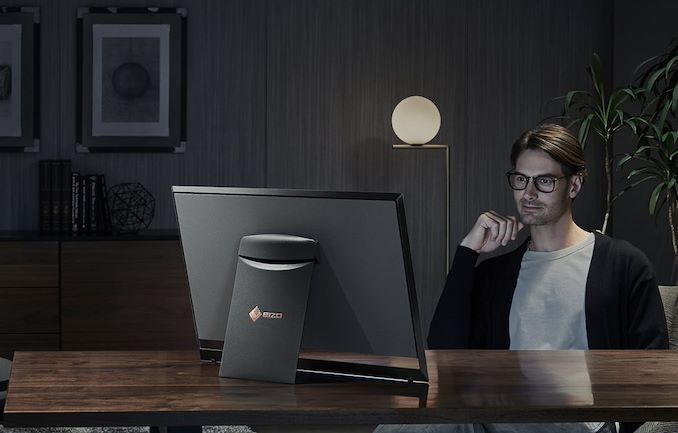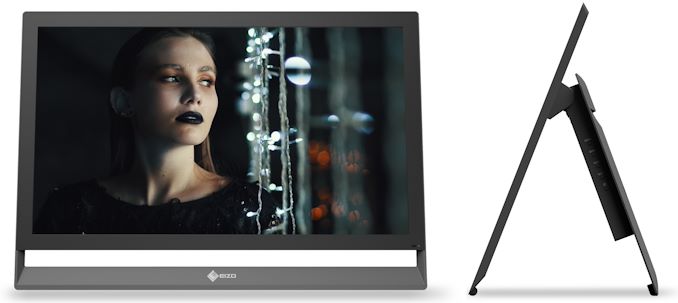EIZO Expands Availability of OLED Foris Nova Monitor
by Anton Shilov on March 26, 2020 5:00 PM EST
EIZO this week expanded the availability of its 21.6-inch 4K OLED Foris Nova display. The display was originally launched back in October as a limited-edition product for the Japanese market. Overall, just 500 units were to be made from that production run. However it would seem that EIZO has modified their plans since then, as according to a press release issued by EIZO China, the Foris Nova is now available globally.
The EIZO Foris Nova uses a 21.6-inch printed OLED panel with a 3840×2160 resolution. The display offers a typical/peak brightness range of 132 - 330 nits, a contrast ratio of 1,000,000:1, and a black-white-black response time of 0.04 ms. The monitor can display 1.07 billion colors, covers 80% of the BT.2020 color space and supports the HDR10 and HLG HDR formats. As for connectivity, the Foris Nova connects to hosts using two HDMI 2.0 inputs, it also has 1 W stereo speakers, one headphone output, and one line out.
EIZO is officially positioning the Foris Nova as a personal entertainment display, though its support for HLG and BT.2020 color gamut makes it handy in professional use cases as well.
Meanwhile, the company's plans to expand the availability of the monitor are a bit odd. As previously noted, when EIZO first announced the monitor they stated they would only make 500 units; but they've yet to actually announce a change to this cap (the official EIZO website still says '500 units' to be made). None the less, the monitor is set to become available to a much larger audience, with the global launch making it available in China and beyond.
| EIZO Foris Nova Specifications | |
| Foris Nova | |
| Panel | 21.6" OLED |
| Native Resolution | 3840 × 2160 |
| Maximum Refresh Rate | 60 Hz |
| Response Time | 0.04 ms (black-white-black) |
| Brightness | minimum: 0.0005 cd/m² typical: 132 cd/m² maximum: 330 cd/m² |
| Contrast | 1,000,000:1 |
| Viewing Angles | 178°/178° horizontal/vertical |
| Pixel Pitch | 0.1245 mm² |
| Pixel Density | 204 ppi |
| Display Colors | 1.07 billion |
| Color Gamut Support | DCI-P3: ? sRGB/Rec 709: ? Adobe RGB: ? SMPTE C: ? Rec2020: 80% |
| Stand | Tilt and height adjustable |
| Inputs | 2 × HDMI (2.0a? 2.0b?) |
| PSU | External |
| Global Price & Date | Q2 2019 |
The worldwide release of EIZO’s Foris Nova monitor could be a good news for the manufacturer of its 21.6-inch printed OLED panel, JOLED (a division of Japan Display Inc., JDI). Expanded availability of the product could indicate that JOLED has started volume production of its 21.6-inch 4K printed OLED panels, which is why EIZO can now expand availability to China and other markets.
Related Reading:
- EIZO Reveals Limited Edition 21.6-Inch Foris Mova OLED Monitor
- JOLED Starts Trial Production of Printed OLED Sheets at 5.5G Plant
- AU Optronics OLED Displays: A New Foldable + A New 17.3-Inch 4K120
- LG's New 55+ inch OLED Plant in China Opens: Over 1m+ per Year
Source: EIZO China (via Sina Tech, OLED-Info)











24 Comments
View All Comments
Pyrostemplar - Thursday, March 26, 2020 - link
Interesting. Just a curiosity, aren't OLED contrast ratio typically infinite? With zero light on the blacks...Not that it would make any perceivable difference compared to the quoted 1000000:1
Oxford Guy - Thursday, March 26, 2020 - link
The panel probably reflects some light and has some degree of opacity. To truly have infinite contrast you would have to have a completely transparent panel with a surface that has perfectly absorbent black.melgross - Tuesday, March 31, 2020 - link
I’ve always thought these numbers for OLEDs to be ridiculous. They’re pretty much meaningless. For most uses LCDs have greater practical contrast, with much higher brightness levels, while the difference in black levels are not that great anymore. Unless you’re in darkness, the eye gets its black levels from the greatest amount of brightness. That’s because our iris closes down depending on the brightest levels, where they are a significant amount. That makes black levels look darker. Even in darker environments that true.brucethemoose - Thursday, March 26, 2020 - link
Yours for only (*puts pinky on mouth*) 100 billion dollars!StevoLincolnite - Thursday, March 26, 2020 - link
Need a 32" variant...Valantar - Friday, March 27, 2020 - link
I believe I said this the last time around too, but I wonder how far back from the table that guy is sitting to make a 21.6" monitor look that big relative to him.Also, that brightness is downright awful.
Guspaz - Friday, March 27, 2020 - link
Is it? I keep my display at 150nit, because I find the common calibration recommendation of 100 nit a bit too dim, so 132 seems fine.A bigger concern is brightness consistency. One of the big problems with computer OlED displays to date has been their terrible accuracy as the percentage of the screen displaying bright colours increases. They can’t drive their entire panels at normal brightness levels, so they dim and colours shift. If this one has solved that, it’ll be a hit.
Valantar - Friday, March 27, 2020 - link
That depends entirely on your environment, but if the area where the screen is used is _ever_ lit even indirectly by sunlight it will appear so dark as to be unusable. 132 nits is dim even in a moderately lit indoor setting.close - Friday, March 27, 2020 - link
It also depends on age. The OLED monitor I used started being terribly nonuniform with hints that pixels were burned in. Needless to say Dell didn't cover this under the warranty. So I would not really touch an OLED computer monitor that I intend to use for more than a year or so.Oxford Guy - Friday, March 27, 2020 - link
If you're doing any sort of color-critical work you should have your lighting under control.OLED pixels degrade, especially blue subpixels. The worst thing you can do with OLED is pump up the brightness. White subpixels have been added to offset the blue loss some but they can only do so much and I don't know if such a small dense panel like this one even uses those.
Also, people should take a lutein supplement or eat red-flowered marigold petals. It really does improve one's visual contrast.